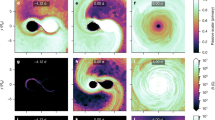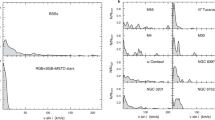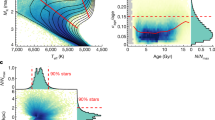Abstract
Recent high-quality Hubble Space Telescope photometry shows that the main-sequence stars of young star clusters form two discrete components in the colour–magnitude diagram. On the basis of their distribution in the colour–magnitude diagram, we show that stars of the blue main-sequence component can be understood as slow rotators originating from stellar mergers. We derive the masses of the blue main-sequence stars, and find that they follow a nearly flat mass function, which supports their unusual formation path. Our results imply that the cluster stars gain their mass in two different ways: by disk accretion leading to rapid rotation, contributing to the red main sequence, or by binary merger leading to slow rotation, populating the blue main sequence. We also derive the approximate merger time of the individual stars of the blue main-sequence component, and find a strong early peak in the merger rate, with a lower-level merger activity prevailing for tens of millions of years. This supports recent binary-formation models, and explains new velocity dispersion measurements for members of young star clusters. Our findings shed new light on the origin of the bimodal mass, spin and magnetic-field distributions of main-sequence stars.
This is a preview of subscription content, access via your institution
Access options
Access Nature and 54 other Nature Portfolio journals
Get Nature+, our best-value online-access subscription
$29.99 / 30 days
cancel any time
Subscribe to this journal
Receive 12 digital issues and online access to articles
$119.00 per year
only $9.92 per issue
Buy this article
- Purchase on Springer Link
- Instant access to full article PDF
Prices may be subject to local taxes which are calculated during checkout




Similar content being viewed by others
Data availability
The observational data in this work can be found at https://doi.org/10.5281/zenodo.5770868. The MESA inlist files used to compute the single- and binary-star models in this work can be downloaded at: https://doi.org/10.5281/zenodo.5233209.
References
Iben, J. I. Stellar evolution within and off the main sequence. Annu. Rev. Astron. Astrophys. 5, 571–626 (1967).
Gaia Collaboration et al. Gaia Data Release 2. Observational Hertzsprung–Russell diagrams. Astron. Astrophys. 616, A10 (2018).
Gratton, R. G., Carretta, E. & Bragaglia, A. Multiple populations in globular clusters. Lessons learned from the Milky Way globular clusters. Astron. Astrophys. Rev. 20, 50 (2012).
Milone, A. P. et al. The Hubble Space Telescope UV Legacy Survey of Galactic globular clusters—IX. The atlas of multiple stellar populations. Mon. Not. R. Astron. Soc. 464, 3636–3656 (2017).
Milone, A. P., Bedin, L. R., Piotto, G. & Anderson, J. Multiple stellar populations in Magellanic Cloud clusters. I. An ordinary feature for intermediate age globulars in the LMC? Astron. Astrophys. 497, 755–771 (2009).
Milone, A. P. et al. Multiple stellar populations in Magellanic Cloud clusters—IV. The double main sequence of the young cluster NGC 1755. Mon. Not. R. Astron. Soc. 458, 4368–4382 (2016).
Li, C., de Grijs, R., Deng, L. & Milone, A. P. Discovery of extended main-sequence turnoffs in four young massive clusters in the Magellanic Clouds. Astrophys. J. 844, 119 (2017).
Milone, A. P. et al. Multiple stellar populations in Magellanic Cloud clusters—VI. A survey of multiple sequences and Be stars in young clusters. Mon. Not. R. Astron. Soc. 477, 2640–2663 (2018).
Li, C. et al. Extended main-sequence turnoffs in the double cluster h and χ Persei: the complex role of stellar rotation. Astrophys. J. 876, 65 (2019).
Mucciarelli, A., Dalessandro, E., Ferraro, F. R., Origlia, L. & Lanzoni, B. No evidence of chemical anomalies in the bimodal turnoff cluster NGC 1806 in the Large Magellanic Cloud. Astrophys. J. Lett. 793, L6 (2014).
Bastian, N. & de Mink, S. E. The effect of stellar rotation on colour–magnitude diagrams: on the apparent presence of multiple populations in intermediate age stellar clusters. Mon. Not. R. Astron. Soc. 398, L11–L15 (2009).
Dupree, A. K. et al. NGC 1866: first spectroscopic detection of fast-rotating stars in a young LMC cluster. Astrophys. J. Lett. 846, L1 (2017).
Marino, A. F. et al. Different stellar rotations in the two main sequences of the young globular cluster NGC 1818: the first direct spectroscopic evidence. Astron. J. 156, 116 (2018).
Bastian, N. et al. Extended main sequence turnoffs in open clusters as seen by Gaia—I. NGC 2818 and the role of stellar rotation. Mon. Not. R. Astron. Soc. 480, 3739–3746 (2018).
Sun, W., Li, C., Deng, L. & de Grijs, R. Tidal-locking-induced stellar rotation dichotomy in the open cluster NGC 2287? Astrophys. J. 883, 182 (2019).
Kamann, S. et al. How stellar rotation shapes the colour–magnitude diagram of the massive intermediate-age star cluster NGC 1846. Mon. Not. R. Astron. Soc. 492, 2177–2192 (2020).
D’Antona, F. et al. Stars caught in the braking stage in young Magellanic Cloud clusters. Nat. Astron. 1, 0186 (2017).
Huang, W., Gies, D. R. & McSwain, M. V. A stellar rotation census of B stars: from ZAMS to TAMS. Astrophys. J. 722, 605–619 (2010).
Zorec, J. & Royer, F. Rotational velocities of A-type stars. IV. Evolution of rotational velocities. Astron. Astrophys. 537, A120 (2012).
Dufton, P. L. et al. The VLT-FLAMES Tarantula Survey. X. Evidence for a bimodal distribution of rotational velocities for the single early B-type stars. Astron. Astrophys. 550, A109 (2013).
Goudfrooij, P., Puzia, T. H., Chandar, R. & Kozhurina-Platais, V. Population parameters of intermediate-age star clusters in the Large Magellanic Cloud. III. Dynamical evidence for a range of ages being responsible for extended main-sequence turnoffs. Astrophys. J. 737, 4 (2011).
Correnti, M., Goudfrooij, P., Bellini, A., Kalirai, J. S. & Puzia, T. H. Dissecting the extended main-sequence turn-off of the young star cluster NGC 1850. Mon. Not. R. Astron. Soc. 467, 3628–3641 (2017).
Niederhofer, F., Hilker, M., Bastian, N. & Silva-Villa, E. No evidence for significant age spreads in young massive LMC clusters. Astron. Astrophys. 575, A62 (2015).
Niederhofer, F., Georgy, C., Bastian, N. & Ekström, S. Apparent age spreads in clusters and the role of stellar rotation. Mon. Not. R. Astron. Soc. 453, 2070–2074 (2015).
Cordoni, G. et al. Extended main-sequence turnoff as a common feature of Milky Way open clusters. Astrophys. J. 869, 139 (2018).
Yang, W. The effects of binary stars on the color–magnitude diagrams of young-age massive star clusters. Astrophys. J. 860, 132 (2018).
Bastian, N. et al. On the origin of the bimodal rotational velocity distribution in stellar clusters: rotation on the pre-main sequence. Mon. Not. R. Astron. Soc. 495, 1978–1983 (2020).
Schneider, F. R. N., Izzard, R. G., Langer, N. & de Mink, S. E. Evolution of mass functions of coeval stars through wind mass loss and binary interactions. Astrophys. J. 805, 20 (2015).
Wang, C. et al. Effects of close binary evolution on the main-sequence morphology of young star clusters. Astrophys. J. Lett 888, L12 (2020).
Tokovinin, A. & Moe, M. Formation of close binaries by disc fragmentation and migration, and its statistical modelling. Mon. Not. R. Astron. Soc. 491, 5158–5171 (2020).
Schneider, F. R. N. et al. Stellar mergers as the origin of magnetic massive stars. Nature 574, 211–214 (2019).
Donati, J. F. & Landstreet, J. D. Magnetic fields of nondegenerate stars. Annu. Rev. Astron. Astrophys. 47, 333–370 (2009).
Lin, M.-K., Krumholz, M. R. & Kratter, K. M. Spin-down of protostars through gravitational torques. Mon. Not. R. Astron. Soc. 416, 580–590 (2011).
Ramírez-Agudelo, O. H. et al. The VLT-FLAMES Tarantula Survey. XXI. Stellar spin rates of O-type spectroscopic binaries. Astron. Astrophys. 580, A92 (2015).
Ekström, S., Meynet, G., Maeder, A. & Barblan, F. Evolution towards the critical limit and the origin of Be stars. Astron. Astrophys. 478, 467–485 (2008).
Hastings, B., Wang, C. & Langer, N. The single star path to Be stars. Astron. Astrophys. 633, A165 (2020).
Korntreff, C., Kaczmarek, T. & Pfalzner, S. Towards the field binary population: influence of orbital decay on close binaries. Astron. Astrophys. 543, A126 (2012).
Sana, H. et al. Binary interaction dominates the evolution of massive stars. Science 337, 444–446 (2012).
Sana, H. et al. A dearth of short-period massive binaries in the young massive star forming region M 17. Evidence for a large orbital separation at birth? Astron. Astrophys. 599, L9 (2017).
Schneider, F. R. N., Podsiadlowski, P., Langer, N., Castro, N. & Fossati, L. Rejuvenation of stellar mergers and the origin of magnetic fields in massive stars. Mon. Not. R. Astron. Soc. 457, 2355–2365 (2016).
Ramírez-Tannus, M. C. et al. A relation between the radial velocity dispersion of young clusters and their age. Evidence for hardening as the formation scenario of massive close binaries. Astron. Astrophys. 645, L10 (2021).
Baumgardt, H. & Klessen, R. S. The role of stellar collisions for the formation of massive stars. Mon. Not. R. Astron. Soc. 413, 1810–1818 (2011).
Kozai, Y. Secular perturbations of asteroids with high inclination and eccentricity. Astron. J. 67, 591–598 (1962).
Eggleton, P. P. & Kiseleva-Eggleton, L. Orbital evolution in binary and triple stars, with an application to SS Lacertae. Astrophys. J. 562, 1012–1030 (2001).
Wu, D.-H., Wang, S., Zhou, J.-L., Steffen, J. H. & Laughlin, G. TTV-determined masses for warm Jupiters and their close planetary companions. Astron. J. 156, 96 (2018).
Ferrario, L., Pringle, J. E., Tout, C. A. & Wickramasinghe, D. T. The origin of magnetism on the upper main sequence. Mon. Not. R. Astron. Soc. 400, L71–L74 (2009).
Petit, V. et al. A magnetic confinement versus rotation classification of massive-star magnetospheres. Mon. Not. R. Astron. Soc. 429, 398–422 (2013).
Braithwaite, J. & Spruit, H. C. A fossil origin for the magnetic field in A stars and white dwarfs. Nature 431, 819–821 (2004).
Fossati, L. et al. Evidence of magnetic field decay in massive main-sequence stars. Astron. Astrophys. 592, A84 (2016).
Paxton, B. et al. Modules for Experiments in Stellar Astrophysics (MESA). Astrophys. J. Suppl. 192, 3 (2011).
Paxton, B. et al. Modules for Experiments in Stellar Astrophysics (MESA): planets, oscillations, rotation, and massive stars. Astrophys. J. Suppl. 208, 4 (2013).
Paxton, B. et al. Modules for Experiments in Stellar Astrophysics (MESA): binaries, pulsations, and explosions. Astrophys. J. Suppl. 220, 15 (2015).
Paxton, B. et al. Modules for Experiments in Stellar Astrophysics (MESA): pulsating variable stars, rotation, convective boundaries, and energy conservation. Astrophys. J. Suppl. 243, 10 (2019).
Brott, I. et al. Rotating massive main-sequence stars. I. Grids of evolutionary models and isochrones. Astron. Astrophys. 530, A115 (2011).
Claret, A. & Torres, G. The dependence of convective core overshooting on stellar mass. Astron. Astrophys. 592, A15 (2016).
Castro, N. et al. The spectroscopic Hertzsprung–Russell diagram of galactic massive stars. Astron. Astrophys. 570, L13 (2014).
Schootemeijer, A., Langer, N., Grin, N. J. & Wang, C. Constraining mixing in massive stars in the Small Magellanic Cloud. Astron. Astrophys. 625, A132 (2019).
Martinet, S. et al. Convective core sizes in rotating massive stars. I. Constraints from solar metallicity OB field stars. Astron. Astrophys. 648, A126 (2021).
Yang, W. & Tian, Z. The effects of the overshooting of the convective core on main-sequence turnoffs of young- and intermediate-age star clusters. Astrophys. J. 836, 102 (2017).
Heger, A., Langer, N. & Woosley, S. E. Presupernova evolution of rotating massive stars. I. Numerical method and evolution of the internal stellar structure. Astrophys. J. 528, 368–396 (2000).
Goldreich, P. & Schubert, G. Differential rotation in stars. Astrophys. J. 150, 571–587 (1967).
Fricke, K. Instabilität stationärer rotation in sternen. Z. Astrophys. 68, 317–344 (1968).
Eddington, A. S. Circulating currents in rotating stars. Observatory 48, 73–75 (1925).
Chaboyer, B. & Zahn, J.-P. Effect of horizontal turbulent diffusion on transport by meridional circulation. Astron. Astrophys. 253, 173–177 (1992).
Spruit, H. C. Dynamo action by differential rotation in a stably stratified stellar interior. Astron. Astrophys. 381, 923–932 (2002).
Heger, A., Woosley, S. E. & Spruit, H. C. Presupernova evolution of differentially rotating massive stars including magnetic fields. Astrophys. J. 626, 350–363 (2005).
Vink, J. S., de Koter, A. & Lamers, H. J. G. L. M. Mass-loss predictions for O and B stars as a function of metallicity. Astron. Astrophys. 369, 574–588 (2001).
Hamann, W.-R., Koesterke, L. & Wessolowski, U. Spectral analyses of the Galactic Wolf–Rayet stars: hydrogen–helium abundances and improved stellar parameters for the WN class. Astron. Astrophys. 299, 151–162 (1995).
Prša, A. et al. Nominal values for selected solar and planetary quantities: IAU 2015 Resolution B3. Astron. J. 152, 41 (2016).
Kurucz, R. L. SYNTHE Spectrum Synthesis Programs and Line Data (Smithsonian Astrophysical Observatory, 1993).
Kurucz, R. L. ATLAS: a Computer Program for Calculating Model Stellar Atmospheres Special Report 309 (SAO, 1970).
Wellstein, S. & Langer, N. Implications of massive close binaries for black hole formation and supernovae. Astron. Astrophys. 350, 148–162 (1999).
Langer, N. Coupled mass and angular momentum loss of massive main sequence stars. Astron. Astrophys. 329, 551–558 (1998).
Glebbeek, E., Gaburov, E., Portegies Zwart, S. & Pols, O. R. Structure and evolution of high-mass stellar mergers. Mon. Not. R. Astron. Soc. 434, 3497–3510 (2013).
Schneider, F. R. N. et al. Long-term evolution of a magnetic massive merger product. Mon. Not. R. Astron. Soc. 495, 2796–2812 (2020).
Sills, A., Adams, T. & Davies, M. B. Blue stragglers as stellar collision products: the angular momentum question. Mon. Not. R. Astron. Soc. 358, 716–725 (2005).
Rain, M. J. et al. The blue straggler population of the open clusters Trumpler 5, Trumpler 20, and NGC 2477. Astron. J. 161, 37 (2021).
Acknowledgements
The research leading to these results has received funding from the European Research Council (ERC) under the European Union’s Horizon 2020 research and innovation programme (grant agreement 772225: MULTIPLES). C.W. acknowledges funding from a CSC scholarship. This work has received funding from the ERC under the European Union’s Horizon 2020 research innovation programme (grant agreement ERC-StG 2016, 716082 ‘GALFOR’, principal investigator A.M., http://progetti.dfa.unipd.it/GALFOR). A.M. acknowledges support from MIUR through the FARE project R164RM93XW SEMPLICE (principal investigator A.M.) and the PRIN programme 2017Z2HSMF (principal investigator Bedin). H.S. and J.B. acknowledge support from the FWO Odysseus programme under project G0F8H6N. N.C. gratefully acknowledges funding from the Deutsche Forschungsgemeinschaft (DFG)—CA 2551/1-1. D.J.L. acknowledges support from the Spanish Government Ministerio de Ciencia, Innovación y Universidades through grants PGC-2018-091 3741-B-C22 and from the Canarian Agency for Research, Innovation and Information Society (ACIISI) of the Canary Islands Government, and the European Regional Development Fund (ERDF), under grant ProID2017010115. P.M. acknowledges support from FWO junior postdoctoral fellowship 12ZY520N. S.E.d.M. acknowledges funding by the Netherlands Organization for Scientific Research (NWO) as part of the Vidi research programme BinWaves with project number 639.042.728.
Author information
Authors and Affiliations
Contributions
C.W., A.S., B.H. and X.-T.X. performed the stellar evolution calculations, based on earlier work by P.M. and on his advice. N.L. carried out the analysis and interpretation of the results, together with C.W., A.S., B.H. and S.E.d.M. A.M., J.B., H.S., N.C., D.J.L. and A.d.K. provided an interpretation of the related observations. All authors reviewed the manuscript.
Corresponding author
Ethics declarations
Competing interests
The authors declare no competing interests.
Peer review
Peer review information
Nature Astronomy thanks the anonymous reviewers for their contribution to the peer review of this work.
Additional information
Publisher’s note Springer Nature remains neutral with regard to jurisdictional claims in published maps and institutional affiliations.
Supplementary information
Supplementary Information
Supplementary Sections A–E, Tables 1 and 2 and Figs. 1–20.
Rights and permissions
About this article
Cite this article
Wang, C., Langer, N., Schootemeijer, A. et al. Stellar mergers as the origin of the blue main-sequence band in young star clusters. Nat Astron 6, 480–487 (2022). https://doi.org/10.1038/s41550-021-01597-5
Received:
Accepted:
Published:
Issue Date:
DOI: https://doi.org/10.1038/s41550-021-01597-5



